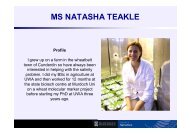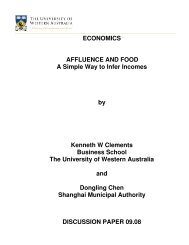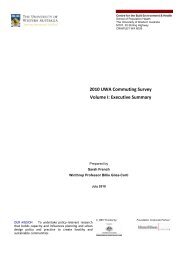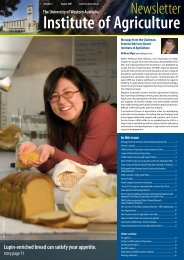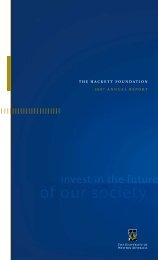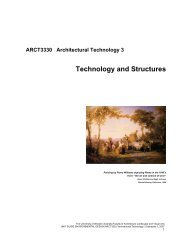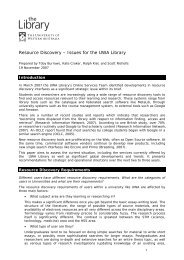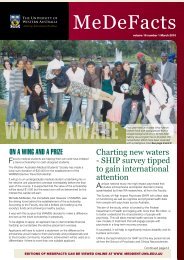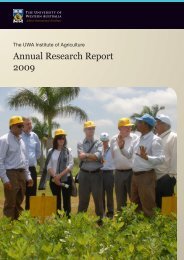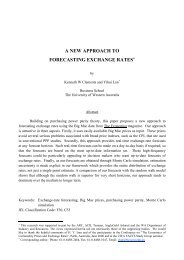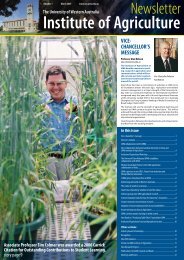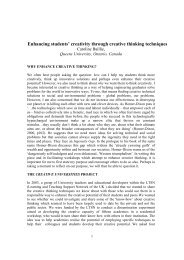MeDeFacts September 2010 - The University of Western Australia
MeDeFacts September 2010 - The University of Western Australia
MeDeFacts September 2010 - The University of Western Australia
Create successful ePaper yourself
Turn your PDF publications into a flip-book with our unique Google optimized e-Paper software.
linked by<br />
a love <strong>of</strong><br />
research<br />
Winthrop Pr<strong>of</strong>essor George Yeoh’s first taste <strong>of</strong> research<br />
during a vacation scholarship was enough for him to<br />
swap his career firmly in that direction.<br />
“It is exploring the unknown,” said the Associate Dean<br />
(Research) in the Faculty. “That is what has been driving me.”<br />
As a young medical student, he started on the path <strong>of</strong> research<br />
when he was awarded a National Heart Foundation vacation<br />
scholarship in 1968 and was supervised by Pr<strong>of</strong>essor Wilfred<br />
Simmonds, Foundation Pr<strong>of</strong>essor in Physiology.<br />
“I went into the lab to work on lipids and metabolism,” Pr<strong>of</strong>essor<br />
Yeoh said. He enjoyed the research so much that he ended up<br />
switching to a science degree so that he could focus purely on it.<br />
“My parents disowned me, <strong>of</strong> course,” he said. But his newly<br />
chosen career has led to his world-wide reputation in the field <strong>of</strong><br />
research, particularly in liver carcinogenesis, liver stem cells and<br />
liver regeneration.<br />
Pr<strong>of</strong>essor Yeoh later married Valerie, who was Pr<strong>of</strong>essor<br />
Simmonds’ laboratory technician.<br />
And in a neat twist, final year medical student Philippe Giguere-<br />
Simmonds, who is the grandson <strong>of</strong> Pr<strong>of</strong>essor Simmonds, spent<br />
2008 completing a Bachelor <strong>of</strong> Medical Science degree in<br />
Pr<strong>of</strong>essor Yeoh’s laboratory.<br />
Mr Giguere-Simmonds said he embarked on a year <strong>of</strong> research<br />
with a BMedSc because he was a bit fatigued from his medical<br />
studies but did not want to take a year <strong>of</strong>f altogether.<br />
“It was a good decision because I learnt a lot about science and<br />
laboratory research and nitty gritty things like interacting with<br />
colleagues, statistical analysis, cell culture and laboratory<br />
experiments,” he said. “I also learnt scientific writing, how to<br />
read and write and organise it.”<br />
He is “almost 100 per cent” certain he wants to do future<br />
laboratory research and has his eye on training as a physician<br />
and then going into haematology because it is a heavily<br />
research-oriented specialty.<br />
Mr Giguere-Simmonds said he did not know his grandfather as<br />
well as he would have liked but his father, grandfather and he<br />
shared the same sense <strong>of</strong> humour and the same interests,<br />
including science fiction and history.<br />
His father is Supreme Court justice Ralph Simmonds, who is a<br />
UWA law graduate.<br />
Pr<strong>of</strong>essor Yeoh, who believes the BMedSc degree is a great<br />
way for medical students to get involved with research, said Mr<br />
Giguere-Simmonds and he had published a paper together on<br />
liver stem cells.<br />
“We tried to prepare human liver stem cells from human liver<br />
samples,” Pr<strong>of</strong>essor Yeoh said. “<strong>The</strong> only liver samples we<br />
could get from adults were when they were doing resections for<br />
hepatocarcinoma and cut an extra bit <strong>of</strong> liver to make sure they<br />
got all <strong>of</strong> the cancer.<br />
“So we grew up stem cells from the normal tissue. But <strong>of</strong><br />
interest is that the stem cells are tumorigenic. <strong>The</strong> story going<br />
Winthrop Pr<strong>of</strong>essor George Yeoh with<br />
Philippe Giguere-Simmonds who is<br />
holding a photo <strong>of</strong> his grandfather,<br />
Pr<strong>of</strong>essor Wilf Simmonds.<br />
around is that in liver cancer, the<br />
normal tissue is also infiltrated<br />
with cancer stem cells and what<br />
we found supported that idea.”<br />
Pr<strong>of</strong>essor Yeoh is currently<br />
working with colleagues at the<br />
WA Institute for Medical Research<br />
on a protein known as TWEAK<br />
that significantly increases the<br />
growth rate <strong>of</strong> liver progenitor<br />
cells, the stem cells involved in<br />
liver repair.<br />
In results published in the journal<br />
Hepatology, they showed that by<br />
adding TWEAK to liver progenitor<br />
cells growing in culture, the cells<br />
grew twice as fast as normal.<br />
<strong>The</strong> researchers are hopeful<br />
that TWEAK could be injected<br />
directly into a patient’s<br />
damaged liver to help it repair<br />
itself by growing new healthy<br />
cells at a much faster rate.<br />
Pr<strong>of</strong>essor Yeoh said the finding<br />
could be <strong>of</strong> great help for<br />
patients with liver disease by<br />
helping to regenerate their<br />
existing liver quickly, potentially<br />
doing away with the need for<br />
transplants.<br />
“I want to know everything that<br />
tickles my favourite cell,” he said.<br />
- By Cathy Saunders<br />
Pr<strong>of</strong>essor Wilf Simmonds,<br />
Foundation Pr<strong>of</strong>essor in Physiology.<br />
Pr<strong>of</strong>essor Wilf Simmonds<br />
<strong>The</strong> <strong>University</strong> <strong>of</strong> <strong>Western</strong> <strong>Australia</strong> <strong>MeDeFacts</strong> <strong>September</strong> <strong>2010</strong> 5



